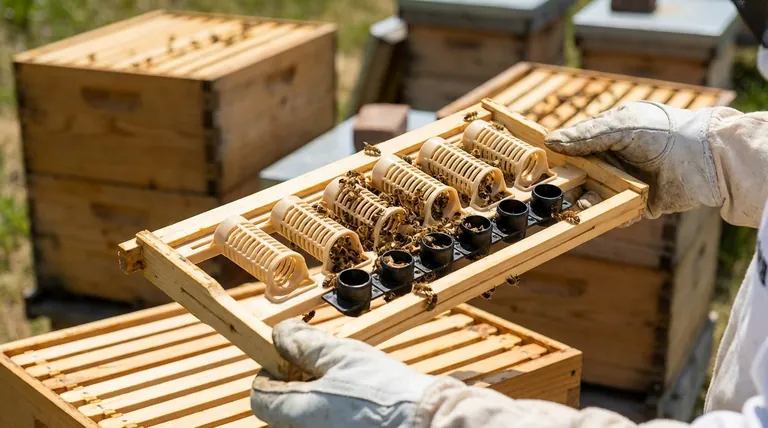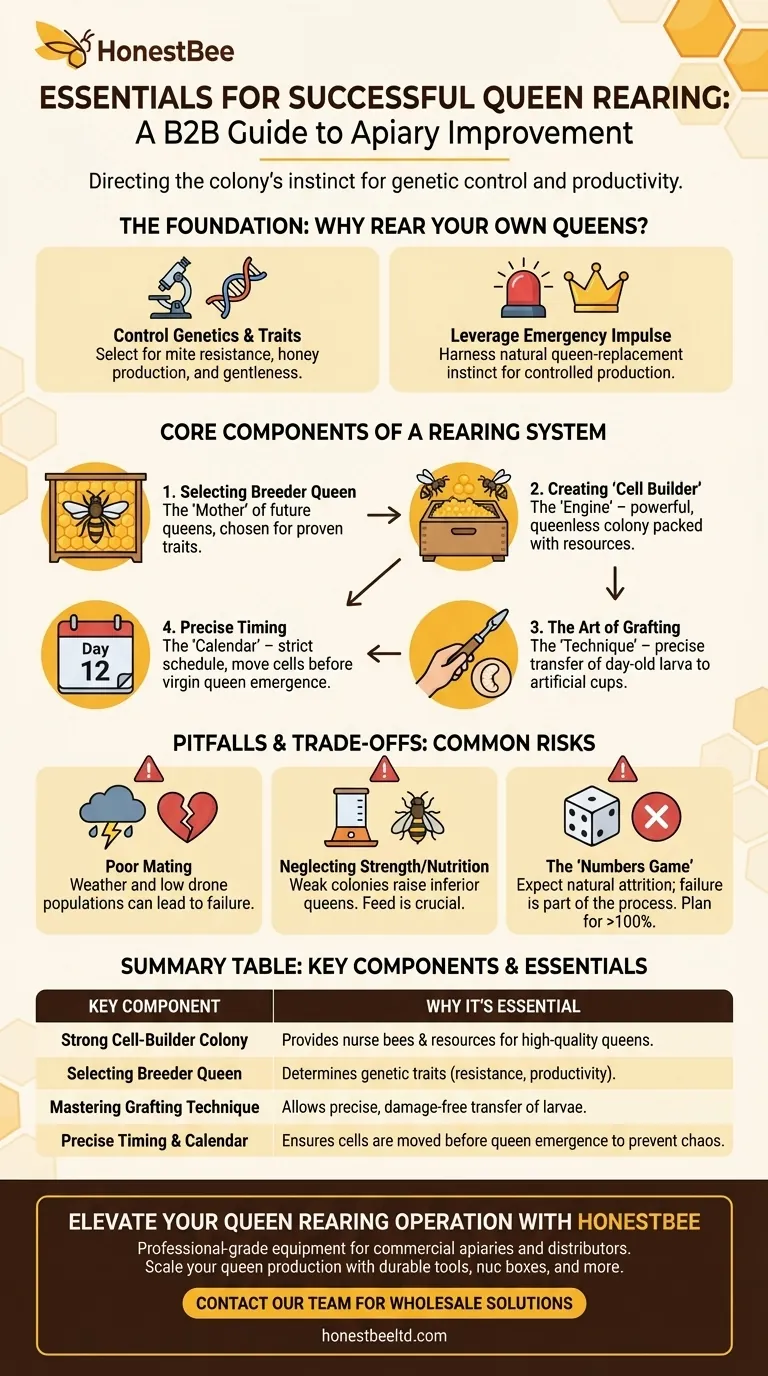At its core, successful queen rearing is the practice of directing a colony's natural queen-replacement instinct to produce queens on your schedule, from your chosen genetic stock. It requires a strong, well-fed "cell-builder" colony, precise timing, and the careful transfer of young larvae into artificial queen cells, a process known as grafting. Mastering this allows you to actively manage your apiary's genetics for desirable traits like mite resistance and productivity.
The single most important factor is creating the perfect conditions for success. This means ensuring your designated "cell-builder" colony is booming with nurse bees, overflowing with resources (pollen and nectar), and convinced it is in a desperate, queenless state, even if only temporarily.

The Foundation: Why Rear Your Own Queens?
Queen rearing moves you from being a bee keeper to a bee breeder. It's about taking proactive control over the health and performance of your apiary.
To Control Genetics and Traits
The primary driver for queen rearing is genetic improvement. By selecting larvae from your best-performing "breeder queen," you can propagate traits you value.
This includes selecting for mite resistance, honey production, gentleness, or overwintering ability. Relying on purchased queens means accepting someone else's breeding goals.
To Leverage the Emergency Impulse
A honey bee colony's survival depends on its queen. When she is gone, the workers initiate an "emergency procedure" to raise a new one.
Successful queen rearing harnesses this powerful, predictable biological response. You are essentially creating a controlled emergency to trick the bees into making dozens of queens for you.
Core Components of a Rearing System
A successful operation is a system with several critical, interlocking parts. Neglecting any one of them will compromise the entire process.
Selecting the Breeder Queen
Everything starts here. Your breeder queen is the mother of all your future queens. Choose a colony that has the exact traits you wish to replicate.
Look for a proven track record over at least one full season. Data on mite loads, temperament, and honey production is far more valuable than guesswork.
Creating the "Cell Builder" Colony
This is the engine of your operation. The cell builder is a powerful colony that is made queenless (or functionally queenless) and tasked with feeding and drawing out the queen cells.
It must be packed with young nurse bees, as they produce the royal jelly needed to raise high-quality queens. It must also have abundant stores of pollen and nectar. A weak or hungry cell builder will produce weak, poorly-fed queens.
The Art of Grafting
Grafting is the physical act of transferring a day-old larva from a worker cell into an artificial queen cup. This is the most technically demanding part of the process.
It requires good eyesight (or magnification), a steady hand, and a gentle touch. The larva must be "floated" off the bottom of the cell in its bed of royal jelly without being damaged.
Precise Timing and Calendar Management
Queen development follows a strict biological timeline. From the day you graft a larva, it takes approximately 12 more days until the virgin queen emerges.
You must have a clear calendar to manage this. This ensures you can move the finished queen cells to mating nucleus hives before they emerge and kill their sisters.
Understanding the Pitfalls and Trade-offs
Queen rearing is a numbers game, and failure is a part of the learning process. Understanding common points of failure is key to improving your success rate.
The Risk of Poorly Mated Queens
Raising a beautiful queen cell is only half the battle. That virgin queen must then go on one or more mating flights and successfully mate with 15-20 drones.
Bad weather can prevent mating flights, and a low drone population in your area can lead to poorly mated queens who fail prematurely. This is a factor largely outside your control in most operations.
Neglecting Colony Strength and Nutrition
This is the single most common mistake. You cannot expect a mediocre colony to raise premium queens.
A lack of nurse bees results in underfed larvae. A lack of incoming pollen and nectar (or supplemental feeding) tells the colony it's a poor time to invest resources, leading to fewer cells being accepted and lower-quality queens.
The "Numbers Game" Reality
Do not expect a 100% success rate. Even experienced breeders see failures. Some grafts won't be accepted. Some queen cells will be torn down. Some queens will fail to emerge or will be lost during mating.
Plan to raise more queens than you need to account for this natural attrition.
Making the Right Choice for Your Operation
Your approach to queen rearing should align with your specific goals.
- If your primary focus is genetic improvement: Be relentless in your record-keeping and selection of the breeder queen. This is the single most important variable for improving stock.
- If your primary focus is self-sufficiency: Master the process of creating a strong cell builder and the grafting technique itself. Consistent production is your key to success.
- If your primary focus is small-scale experimentation: Consider non-grafting methods like the Miller or Hopkins method to learn the principles of timing and cell-builder management before investing in specialized equipment.
By understanding the underlying biology and focusing on the critical inputs, you can take definitive control of your apiary's future.
Summary Table:
| Key Component | Why It's Essential |
|---|---|
| Strong Cell-Builder Colony | Provides the nurse bees and resources (pollen, nectar) needed to raise high-quality queens. |
| Selecting the Breeder Queen | Determines the genetic traits (mite resistance, productivity) of your future queens. |
| Mastering Grafting Technique | Allows for the precise transfer of young larvae to artificial queen cells without damage. |
| Precise Timing & Calendar | Ensures queen cells are moved to mating nucs before virgin queens emerge, preventing chaos. |
Ready to elevate your queen rearing operation with professional-grade equipment?
As a wholesale supplier to commercial apiaries and distributors, HONESTBEE provides the durable, reliable beekeeping supplies you need to scale your queen production successfully. From grafting tools to nucleus hive boxes, our equipment is designed to support the precise demands of large-scale breeding programs.
Contact our team today to discuss your specific needs and learn how our wholesale solutions can help you build a stronger, more productive apiary.
Visual Guide

Related Products
- No Grafting Queen Rearing Kit: System for Royal Jelly Production and Queen Rearing
- Nicot Queen Rearing Kit for Beekeeping and Grafting in Nicot System
- Brown Nicot Queen Cell Cups for Breeding Queen Bees Beekeeping
- Plastic Chinese Queen Grafting Tool for Bee Queen Rearing
- JZBZ Push-In Queen Cell Cups for Beekeeping
People Also Ask
- How can beekeepers start a honey bee breeding program? Build a Superior, Resilient Apiary
- What are the signs that indicate a colony needs requeening? Protect Your Hive's Health and Productivity
- What is requeening, and why is it performed? Take Control of Your Hive's Health and Productivity
- What do queen rearers do with queens that fail to lay on time? The Critical Quality Control Decision
- What are the two main categories of queen rearing methods? Grafting vs. Non-Grafting Explained



















